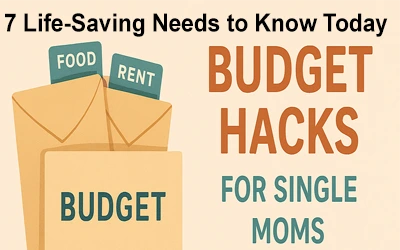
Save Money On Kids Activities
Smart Ways to Save Money on Kids Activities Without Saying No to Fun
“Mom, can I go to summer camp this year?”
“Dad, everyone else in class is taking gymnastics!”
Sound familiar?
Parenting in the United States today comes with more than love, late-night lullabies, and screen time debates. It comes with price tags — and often, very big ones. From sports leagues to STEM programs, music lessons to weekend dance classes, kids’ activities are a beautiful part of growing up — but also a growing expense that’s stretching family budgets thin.
But what if you didn’t have to choose between your child’s growth and your grocery bill?
Let’s break down 30 truly practical, realistic ways to save money on kids’ activities, without depriving your child of enrichment or joy. You’ll walk away with not just tips, but clarity, confidence, and control over how you support your child — and your finances.
Why Do Kids’ Activities Cost So Much in the U.S.?
America’s extracurricular culture has grown into a billion-dollar industry. Sports teams often require uniforms, equipment, registration fees, and travel. Private lessons in music or dance? Easily $30–$100 per session. Even seemingly small things like school clubs often involve hidden fees for events or supplies.
And then there’s the “comparison pressure” — the unspoken push to give your child every possible advantage, just like “everyone else.”
It’s no wonder so many parents feel guilty or overwhelmed trying to keep up.
But guilt doesn’t pay the bills — strategy does.
The Hidden Financial Toll on Parents
Every dollar spent on non-essential activities can mean less for savings, bills, or emergency funds. If you’re living paycheck-to-paycheck, those costs add up fast.
But more than just money, it’s the mental load that wears parents down. Constant scheduling, fee reminders, and negotiating with kids about what’s “affordable” creates ongoing tension.
So here’s the mission: Keep the joy, cut the cost.
Low Cost Activities for Kids
Why Is Kids' Fun So Expensive in the First Place?
Let’s break down the cost of “just a day out” in the U.S.:
Activity | Estimated Cost (Family of 4) |
Movie + Snacks | $60–$75 |
Zoo or Aquarium Tickets | $80–$120 |
Trampoline Park or Arcade | $70–$100 |
Children’s Museum | $50–$80 |
Kid’s Art Class | $25–$45 per child |
Add in gas, snacks, and extras — and suddenly your “cheap weekend” just cost more than your electric bill.
Save Money On Kids Activities
The Emotional Pressure No One Talks About
Many parents don’t just feel financial pressure — they feel emotional pressure.
- To keep up with other families
- To avoid guilt if their child is “bored”
- To give their kids everything they didn’t have growing up
But truthfully?
Kids don’t remember the ticket price.
They remember how you made them feel.
What Kids Actually Want (Hint: It’s Not Expensive)
Research and real-life stories agree:
- Kids thrive on routine, creativity, and quality time
- They remember silly backyard games, blanket forts, and pancakes on a Sunday
- They want your attention more than any theme park
So let’s flip the narrative.
Let’s give them fun, learning, and bonding — while protecting your budget.
Let’s explore 30 smart, actionable, and psychology-backed ways to do just that.
>>30 Practical & Proven Ideas to Save Money on Kids’ Activities<<
Home-Based Activities
1. Start a Rotating Activity Group: Instead of paying for weekend classes, gather a group of parents to rotate hosting activity days. One Saturday is baking day, another is science experiments, another is crafts. It’s fun, social, and free (minus a few supplies).
2. Create At-Home Learning Clubs: Chess, storytelling, nature walks. Rotate homes weekly. It saves money and builds community.
3. Utilize YouTube & Online Tutorials: From dance to drawing, thousands of high-quality lessons are free online. Set up a dedicated time each week to “attend” these sessions at home, using what you already have.
4. Create Family Activity Nights: Movie marathons, scavenger hunts, homemade pizza night — fun doesn’t have to be expensive. Rotate who picks the activity and make it a weekly tradition.
5. Make the Most of School Breaks: Instead of enrolling in costly break camps, use that time for DIY projects, nature days, or free local library events. Plan ahead and keep a loose schedule to stay sane.
Backyard & Outdoor Adventures
6. Buy Gear Second-Hand: Kids outgrow things fast. Sites like Facebook Marketplace, OfferUp, or local consignment shops often have like-new sports equipment, uniforms, and instruments for a quarter of the original price. You can also resell once your child’s done — a double win.
7. Share Transportation Duties: Carpooling to and from activities saves gas, time, and sanity. Coordinate with other parents early in the season for a smoother routine.
8. Prioritize Free Community Events: Watch for free weekend events in your town: festivals, parades, museum days, kids’ expos. They often include games, crafts, and performances your child will love.
9. Pause Activities During Financial Stress: It’s okay to take a break. If finances are tight one month, skip a session and replace it with home-based activities. You’re not failing — you’re adjusting wisely.
10. Buy Annual Memberships Instead of Paying Per Visit: Museums, zoos, and activity centers often offer annual passes that save money in the long run. These also give you reliable weekend options without extra spending.
Educational But Fun Activities
11. Opt for Free Trial Classes: Many organizations offer the first class or lesson free. Before committing to a 12-week karate program, try a couple of free sessions across different places to test your child’s interest and avoid wasting money.
12. Use Local Libraries for Hidden Gems: Today’s libraries are more than books. Many offer free coding clubs, LEGO meetups, art workshops, or even yoga for kids. Check their event calendar monthly — you’ll be surprised.
13. Choose Multi-Child Discounts: If you have more than one child, seek out programs that offer family discounts. Even 10–15% off per child adds up when it’s a year-long commitment.
14. Re-Evaluate Activities Every Quarter: Sometimes we keep paying for activities our kids have lost interest in. Every three months, sit down and ask: “Do you still enjoy this?” Make room for quitting when it’s no longer joyful.
15. Attend School-Sponsored Programs: Clubs run by schools — whether it’s robotics, drama, or journalism are often much cheaper than private alternatives and still offer real skill-building.
16. Teach Your Child About Costs: Older kids can learn about budgeting by seeing how much each activity costs. Let them “rank” what they value most. It builds decision-making skills and appreciation.
Budget-Friendly Family Activities
Apps & Digital Tools
17. Track Every Dollar Spent: You can’t cut costs you’re not tracking. Use a free budgeting app like Mint or EveryDollar to see where activity money is going. Sometimes, seeing it laid out reveals easy cuts.
18. Use Loyalty Programs & Coupons: Apps like Prize Pursuit, Honey, or store-specific loyalty cards often offer discounts on gear, supplies, or even registration fees.
Local & Community Resources
19. Set a Family Activity Budget First: Instead of saying “yes” or “no” to every activity on the fly, decide how much you can realistically spend per month. Discuss this budget openly with your kids. It builds healthy boundaries and teaches them about money early. Instead of feeling like the “bad guy” who always says no, you become the family planner who helps balance dreams and dollars.
20. Use Community Centers: Most cities and counties offer incredibly affordable youth programs through parks and recreation departments. From swimming to art classes, these options cost a fraction of private alternatives and are often taught by experienced local professionals. Plus, your taxes already support these programs — so why not use what you’re paying for?
21. Look for Scholarships or Fee Waivers: Many local clubs, sports leagues, and arts organizations offer financial aid but don’t advertise it loudly. Ask directly — you’ll be surprised how often a simple inquiry can open doors. These waivers are meant for hardworking families just like yours.
22. Swap Skills with Other Parents: Can you teach piano? Maybe another parent knows soccer. Bartering skills within your community lets kids learn more without extra cost. Consider starting a parent exchange network through school or Facebook groups.
23. Limit to One Paid Activity Per Season: Over-scheduling drains wallets and kids’ energy. Let your child pick one paid activity per season, and fill the rest of their time with lower-cost hobbies, playdates, and family activities.
Low Cost Weekend Ideas for Families with Kids
24. Ask for Birthday or Holiday Contributions: Instead of more toys, ask grandparents to chip in for activity costs like summer camp or soccer cleats. Create a “gift registry” with experience-based items.
25. Volunteer in Exchange for Discounts: Many programs offer discounts to parents who help out — whether by coaching, setting up equipment, or organizing snacks. You save money and stay involved.
26. Pick Activities With Built-In Free Time: Some programs pack your child’s schedule five days a week. Instead, choose options that offer twice-a-week sessions, giving your child downtime and saving your wallet extra costs.
27. Find “Family Package” Deals: Some studios or camps offer a better price if more than one family member joins — e.g., a parent + child dance class. Take advantage of bundle deals.
28. Explore Local Churches or Faith Centers: Many churches offer free or low-cost youth programs, from choir to drama to summer camps. You don’t always have to be a member — just respectful and willing.
29. Create a “Yes” Fund: Put aside a small amount monthly into an envelope labeled “Yes.” When your child wants to join something spontaneous, you can say “yes” without guilt.
30. Be Honest With Your Child: If something’s truly out of reach financially, don’t mask it. Instead, say: “We’re saving for something else right now — let’s find a fun alternative together.” Honesty builds trust.
Frugal Summer Activities for Kids
What NOT to Do If You Want to Save Money on Kids Activities
- Don’t assume expensive = better
- Don’t get trapped in monthly subscriptions you forget to cancel
- Don’t try to fill every hour — boredom can spark creativity
- Don’t compare your family to others online
- Don’t feel guilty for saying “we’ll do something else today”
Bonus: Real-Life Budget Activity Planner (Weekly Example)
Day | Activity Idea | Cost |
Monday | Library Storytime + Park Visit | Free |
Tuesday | DIY Playdough + Kitchen Science | $3 |
Wednesday | Printable Games + ABCmouse Trial | Free |
Thursday | Sidewalk Chalk Course + Picnic | $2 |
Friday | Movie Night w/ Homemade Popcorn | $4 |
Saturday | Backyard Treasure Hunt + Bubble Fun | $1 |
Sunday | Family Talent Show + Board Games | Free |
- Total Weekly Cost: ~$10 for 7 days of joy
Real-Life Parent Testimonials / Quotes Section
- “We used to spend $200 a month on weekend fun. Now our kids enjoy backyard scavenger hunts and they’re actually happier!”
— Rachel M., mother of two, Texas - “After switching to free museum days and nature hikes, our family outings became more meaningful and less stressful.”
— John D., father of three, Colorado - “Pinterest crafts saved my sanity during summer break. Who knew glue and paper could bring so much peace?”
— Elena R., single mom, New York - “We cancelled our pricey activity subscriptions and started a DIY movie night tradition at home. Now Fridays are our favorite!”
— Tammy G., Georgia - “My son learned more from building a birdhouse with me than a $300 robotics camp. And we made memories doing it.”
— Rebeka S., Oregon
Get a $1000 Prize Money – A Game-Changer for Your Family Fun!
Ever wondered what a sudden $1000 could do for your family?
Imagine this:
You’re looking for ways to enjoy more time with your kids, but every trip feels like another hit to your wallet. Now picture receiving $1000 in your account—no debt, no loans, just extra cash. What would you do?
Here’s what real parents have done with their reward money:
- Paid for an entire summer of fun local trips and activities
- Bought art supplies, books, and learning kits to keep kids creatively busy
- Signed up for family memberships at museums or science centers
- Replaced broken bicycles, sports gear, or old backyard swings
- Even used part of it to start an emergency fund for future needs
This isn’t a dream. It’s a real offer available to select users who take action now. These campaigns run for a limited time and can vanish once the slots fill up.
How Can You Get the $1000 Prize Money?
Ever wondered what a sudden $1000 could do for your family?
Imagine this:
You’re looking for ways to enjoy more time with your kids, but every trip feels like another hit to your wallet. Now picture receiving $1000 in your account—no debt, no loans, just extra cash. What would you do?
Here’s what real parents have done with their reward money:
- Paid for an entire summer of fun local trips and activities
- Bought art supplies, books, and learning kits to keep kids creatively busy
- Signed up for family memberships at museums or science centers
- Replaced broken bicycles, sports gear, or old backyard swings
- Even used part of it to start an emergency fund for future needs
This isn’t a dream. It’s a real offer available to select users who take action now. These campaigns run for a limited time and can vanish once the slots fill up.
How Can You Get the $1000 Prize Money?
It’s incredibly simple:
- Click the button below
- Sign up with your valid email and details
- Complete a few easy steps to unlock your eligibility
- You’ll receive confirmation if you qualify for the $1000 reward!
No long applications| No credit card needed| No tricky commitments
Why You Shouldn’t Wait
If you’re a parent juggling bills, activities, and daily stress, this $1000 could be your breathing room. A chance to say yes to things you’ve been putting off. Whether it’s investing in your child’s joy or just catching up on life—this reward can change your next few months.
Your Questions Answered
Q. What's the best way to keep my kids active at home for free?
Answer: Try daily dance-offs, YouTube fitness for kids, or family walks. Make it a habit. One dad started a “3 p.m. dance break” each day with his kids, and now they even plan themes. It’s free, silly, and keeps everyone moving—especially on long winter days.
Q. Are museums or zoos ever free for kids or families?
Answer: Yes, many offer free admission days monthly. Also, some libraries let you check out passes to local attractions. If you’re part of any assistance programs (like SNAP or WIC), check Museums for All—they partner with hundreds of places nationwide.
Q. Can couponing help save money on kids’ toys, food, or supplies?
Answer: Using coupons can save a lot of money. Many stores have loyalty programs that offer exclusive discounts. And digital coupons or cashback apps are great savings. Many parents buy school supplies, toys, and other things at low prices with the help of coupons.
Q. What can I do during summer break that doesn’t break the bank?
Answer: You can organize your own summer camps at home without increasing your expenses. You can work on the theme of ‘Space Camp’ or ‘Nature Week’. There are many free hands-on craft, science project and game ideas available on YouTube. One mother saved thousands of dollars doing this and the kids had a lot of fun.
Q. How can I include my child in money-saving habits without making them feel restricted?
Answer: Make saving a game. Teach your children how to compare prices, or earn points for turning off the electricity. Give them the responsibility of making a ‘Budget Night’ dinner so that they can take something from the pantry. When children can make decisions like adults, they will naturally love to save.
Q. Are toy swaps with other families safe and helpful?
Answer: If done correctly, toy swaps are great and safe. Exchanging toys with a familiar neighbor or church group feels like a new toy, and the cost is zero. Of course, toys should be clean and safe, and broken parts should not be taken. It is also a way to increase friendships within the community.
Q. What are some smart ways to reuse or repurpose kids’ items?
Answer: Old clothes can be used to make costumes, which can be used in dress-up games. You can make crafts by folding old puzzles into cut-up paper. You can melt broken candles to create new shapes. Doing these activities with children also helps them become creative and understand the value of things.
Q. Is homeschooling cheaper than traditional school?
Answer: It depends. You save on uniforms, lunches, and transportation, but there are costs for materials or curriculum. Some families make it work by using free online programs, local co-ops, and thrifted supplies. It’s more flexible, which helps control the budget.
Q. How can I reduce screen time without adding more costs?
Answer: You don’t have to buy anything new to reduce screen time. Have a “screen free day” one day a week where the kids can read a book, play outside, or do puzzles. You can give them a little incentive—like having someone fix dinner, or having a sleepover with friends. These don’t cost a lot, but they also make them feel good.
Q. Where can I find exclusive offers or giveaways for families?
Answer: Many people don’t know that family blogs, parenting influencers, and local Facebook groups sometimes offer special discounts or giveaways. If you subscribe to the newsletters of big brands, you can get new offers or free samples in advance. So, if you keep an eye out, you won’t miss out on good offers.
Final Thoughts: It’s Not About Spending More — It’s About Spending Smart
You’re not a bad parent for saying “we can’t afford that right now.”
You’re a smart parent for choosing long-term stability over short-term pressure.
Remember: the best memories often come from the simplest moments — not the ones with price tags attached.
So breathe. Plan wisely. Say yes when it makes sense. Say no without guilt. And always, always, put connection before comparison.
Save Money On Kids Activities
Inexpensive Crafts and Games for Children
Saving Money on Family Outings
Affordable After School Activities for Kids
How to Entertain Kids on a Budget
Budget-Friendly Birthday Party Ideas for Kids
Save Money On Kids Activities



